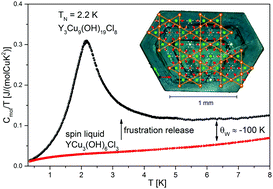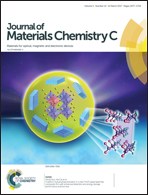Strong magnetic frustration in Y3Cu9(OH)19Cl8: a distorted kagome antiferromagnet
Abstract
We present the crystal structure and magnetic properties of Y3Cu9(OH)19Cl8, a stoichiometric frustrated quantum spin system with slightly distorted kagome layers. Single crystals of Y3Cu9(OH)19Cl8 were grown under hydrothermal conditions. The structure was determined from single crystal X-ray diffraction and confirmed by neutron powder diffraction. The observed structure reveals two different Cu-positions leading to a slightly distorted kagome layer in contrast to the closely related YCu3(OH)6Cl3. Curie–Weiss behavior at high-temperatures with a Weiss-temperature θW of the order of −100 K, shows a large dominant antiferromagnetic coupling within the kagome planes. Specific-heat and magnetization measurements on single crystals reveal an antiferromagnetic transition at TN = 2.2 K indicating a pronounced frustration parameter of θW/TN ≈ 50. Optical transmission experiments on powder samples and single crystals confirm the structural findings. Specific-heat measurements on YCu3(OH)6Cl3 down to 0.4 K confirm the proposed quantum spin-liquid state of that system. Therefore, the two Y–Cu–OH–Cl compounds present a unique setting to investigate closely related structures with a spin-liquid state and a strongly frustrated AFM ordered state, by slightly releasing the frustration in a kagome lattice.



 Please wait while we load your content...
Please wait while we load your content...